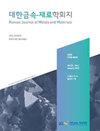Changes in Microstructure, Mechanical and Electrical Properties with Progress of Cold Wire-Drawing for AA1070
IF 1.1
4区 材料科学
Q4 MATERIALS SCIENCE, MULTIDISCIPLINARY
引用次数: 0
Abstract
Commercial AA1070 alloy for electrical wire is severely deformed by the drawing process when a rod with a diameter of 2 mm is greatly reduced to 0.4 mm by multi-pass. Changes in the microstructure, mechanical properties, and electrical properties of the Al alloy during the wire-drawing process were investigated in detail. The as-drawn Al wires showed a deformation structure in which the grains are greatly elongated in the drawing direction, even though recovery and/or partial recrystallization occurred more actively in the specimens which had more than 84% in reduction of cross-sectional area (RA). In addition, the fraction of high angle grain boundaries tended to increase with the increase of RA. For all drawn specimens, the fiber texture of the {110}<111> and {112}<111> components was mainly developed, and their maximum intensity tended to increase with increasing RA. Recrystallization texture of (001)[100] and (110)[001] began to appear at an RA higher than 84%. The hardness tended to increase with increasing RA due to work hardening. In particular, increasing RA to 84% resulted in a great rise in hardness, accompanied by a distinct non-uniformity in hardness in the thickness direction. However, the average hardness hardly changed at RA above 84%, even when RA was increased to 96%. The strength also tended to increase stepwise as RA increased, very similar to the change in hardness. The specimen with an RA of 93% showed the highest tensile strength of 192 MPa, 2.8 times higher than that of the specimen before drawing. The electric conductivity did not decrease significantly, even with extreme increases in RA, and remained at an average value of 61.6 %IACS.AA1070冷拔过程中组织和力学性能的变化
商品用电线用AA1070合金在拉拔过程中,当直径为2mm的棒材经多道次压缩到0.4 mm时,会发生严重变形。详细研究了铝合金在拉丝过程中组织、力学性能和电性能的变化。拉伸后的Al线呈现出晶粒在拉伸方向上明显拉长的变形结构,而截面积减少84%以上的试样(<i>R<sub>A</sub></i>)的恢复和/或部分再结晶更为活跃。此外,高角度晶界的比例随着<i>R<sub>A</sub></i>的增加而增加。对于所有绘制的试样,{110}<111>和{112}& lt; 111年比;随着<i>R<sub>A</sub></i>的增加,其最大强度呈增加的趋势。(001)[100]和(110)[001]的再结晶织构开始出现在A< i>R<sub>A</sub></i>高于84%。随着<i>R<sub>A</sub></i>由于加工硬化。特别是增加<i>R<sub>A</sub></i>到84%时,硬度大幅上升,同时硬度在厚度方向上存在明显的不均匀性。而在<i>R<sub>A</sub></i>84%以上,即使& lt; i> R< sub> A< / sub> & lt; / i>增加到96%。随着<i>R<sub>A</sub></i>增加,非常类似于硬度的变化。带有<i>R<sub>A</sub></i>拉伸强度达到192 MPa,是拉伸前的2.8倍。电导率没有明显下降,即使极端增加<i>R<sub>A</sub></i>,也保持在61.6% IACS的平均值。
本文章由计算机程序翻译,如有差异,请以英文原文为准。
求助全文
约1分钟内获得全文
求助全文
来源期刊

Korean Journal of Metals and Materials
MATERIALS SCIENCE, MULTIDISCIPLINARY-METALLURGY & METALLURGICAL ENGINEERING
CiteScore
1.80
自引率
58.30%
发文量
100
审稿时长
4-8 weeks
期刊介绍:
The Korean Journal of Metals and Materials is a representative Korean-language journal of the Korean Institute of Metals and Materials (KIM); it publishes domestic and foreign academic papers related to metals and materials, in abroad range of fields from metals and materials to nano-materials, biomaterials, functional materials, energy materials, and new materials, and its official ISO designation is Korean J. Met. Mater.
 求助内容:
求助内容: 应助结果提醒方式:
应助结果提醒方式:


